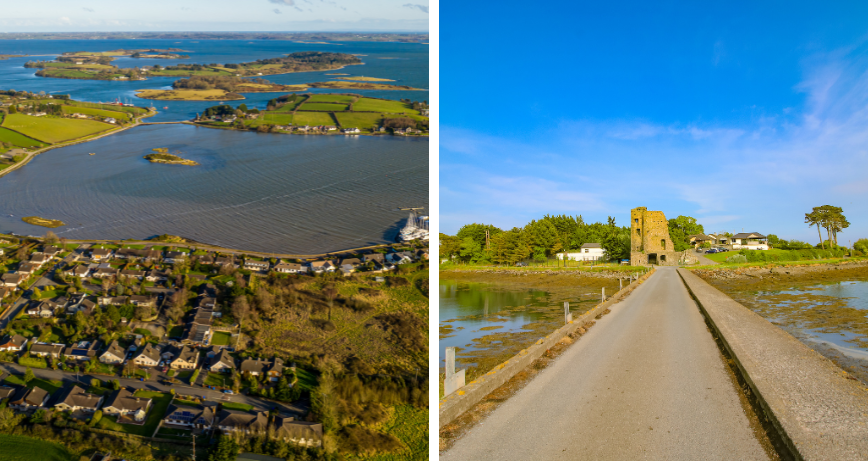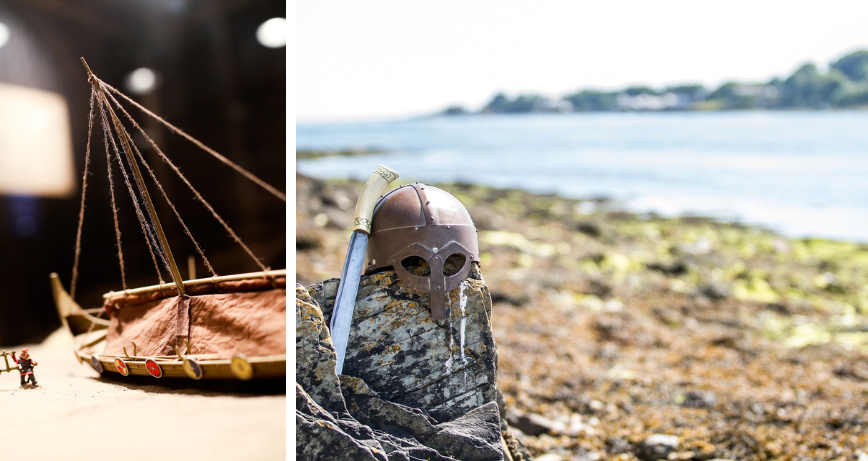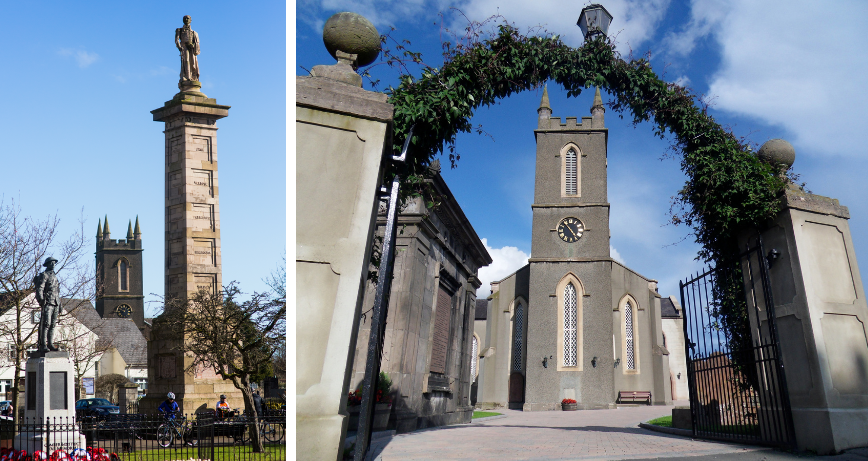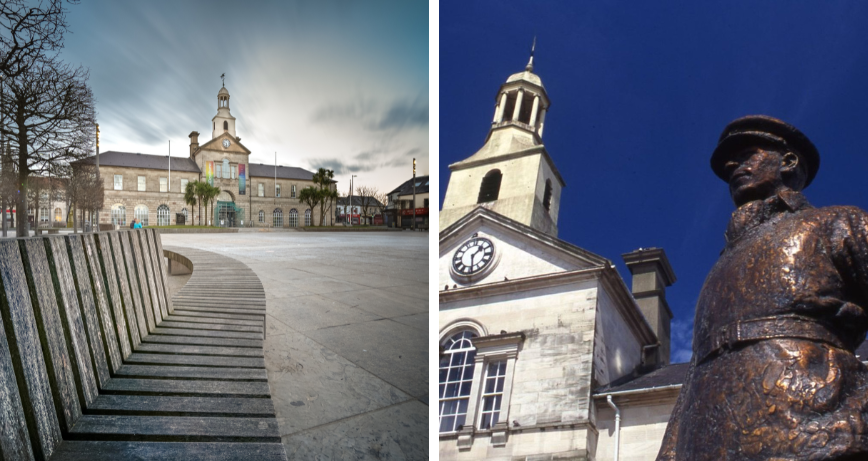Northern Ireland is home to many stories, myths, and legends, with Ards and North Down laying claim to a fair few of its own.
Ruined castles, holy wells, abbeys and military forts where tales of Bronze Age communities, Vikings, early Christian and Ulster-Scots heritage, and the role of this area in the Great Wars, are here to be discovered.
Immerse yourself in our rich heritage, embrace the folkore, and enjoy a warm welcome from the locals - all with a story to tell, here are just a few that you may or may not have heard of…
Bangor
Saint Comgall and the mermaid Lí Ban
The seaside town of Bangor has many nautical tales to tell, one of which concerns a mermaid and some monks. Legend has it that, back in the 6th century, a group of monks travelled from Bangor Mor monastery to deliver a message from Saint Comgall to Rome. En route, they caught a mermaid called Lí Ban in their fishing nets. They informed Saint Comgall who came to them and after speaking with her, baptised her Muirgen, which means ‘born of the sea’.
Bangor Abbey
Find out about the characters who have left impressions on Bangor Abbey, a church near the city centre steeped in history dating back to 55AD! Characters like Columbanus and Gall, Saint Malachy and Assistant Surgeon of the Titanic, local man, John Edward Simpson.
Bangor Castle
Did you know that Bangor Castle (City Hall) has a tunnel which runs from the old Leisure Centre carpark up to the front of the castle?
The tunnel once accessed (illegally by Bangorians) via the old Bangor Castle Leisure Centre, where the Premier Inn now resides, has been the subject of many urban legends. Over the years people suggested it was a smugglers’ escape route, a secret passage from Bangor Abbey to the seafront or a servant’s tunnel relating to the castle. However, the height near the end would not allow regular access for people.
Given the evidence and dimensions the most likely explanation for the structure is a late 18th century/early 19th century drainage network, probably associated with the gardens of the second Castle. Investigations in the 1980s uncovered sherds of old earthenware food and drink vessels, oyster shells and fragments of animal bone which are now amongst a collection in North Down Museum which is attached to the City Hall.
Comber
Rollo Gillespie
The Rollo Gillespie Monument located in Comber Square was built to commemorate the bravery of Major General Robert 'Rollo' Gillespie born in the town in 1766. A list of his battles can be found on the sides of the pillar. He fought in the armies of King George III against the French and their allies and served in the West Indies, India and Indonesia. In 1814, at the beginning of the Gurkha War, Gillespie led an attack on a Nepalese fort at Kalunga where he was fatally wounded. Having been shot through the heart, his reputed last words were “one shot more for the honour of Down”. Gillespie received a posthumous knighthood in the New Year Honours list 1815 and this memorial was unveiled 24 June 1845.
Read more about Rollo Gillespie
Edmund de Wind
Edmund De Wind VC was the only Comber man to win the Victoria Cross, awarded posthumously, in recognition of his valour and self-sacrifice. A plaque can be found at St Mary’s Church in his memory.
Read more about Edmund de Wind
Thomas Andrews
Passing through the entrance of St Mary's Church in the town, to your left you will find the Andrews Mausoleum. It contains no burials but is built over the tomb of the ancestors of Thomas Andrews, Titanic architect.
Read more about Thomas Andrews
Newtownards
Newtownards Town Hall
The Town Hall building is a beautifully restored Georgian Building with a rich history in Conway Square, Newtownards. From Market House and Prison to Civic Offices and now the Ards Arts Centre, the Town Hall in Newtownards has withstood its changing uses and still stands, reflecting over 250 years of history.
There is a prison cell, which was used in the 18th century when the Town Hall building was a Market House, and it still exists today. The small cell would have been used to temporarily house prisoners, and it would have got very cramped in there!
The cell still has its small window with metal grille, which once looked out onto the road running through the building. You can still see the marks and indentations on the window ledge today where prisoners would have leaned on the sill, craning to look out at the street.
Blair Mayne
Located in front of the Town Hall Ards Arts Centre in Newtownards, in Conway Square, is a statue of memorial to Robert Blair 'Paddy' Mayne, a British Army soldier from the town and a founding member of the Special Air Service (SAS).
During World War Two he became one of the British Army's most highly decorated soldiers and was controversially denied a Victoria Cross due to his rebellious behavior.
He had huge success in the sporting field, playing for Ireland and the British and Irish Lions in rugby union.
His bright future in rugby was cut short by the war where he enlisted in the Royal Ulster Rifles, before joining the commandos and then becoming a founder member of the SAS.
After Mayne returned home from the war, he became Secretary to the Law Society of Northern Ireland.
He died young, aged 40, in a local road accident, in 1955.
Market Cross
At the east of High Street in Newtownards the Market Cross was built in 1636 but was destroyed by Commonwealth troops in 1653. The original building was less than 11 feet tall and octagonal in shape with a low door and staircase leading to the roof. The present replacement building was finished in 1666, restoration works took place in 2020 to protect this unique monument. Towns people say that the Cross used to "flow with wine" at the birth of a royal baby.
Strangford Lough
Daft Eddy
You may be familiar with the restaurant Daft Eddy's on Sketrick Island, but did you who the real Daft Eddie was?
Eddie, a simple lad from Mahee Island in Strangford Lough shadowed local smugglers that went by the name of ‘The Merry Hearts of Down’, he tracked the gang’s every move and helped in the search for an abducted magistrate and his daughter. He is the hero of the story Daft Eddie; or, the Smugglers of Strangford Lough: A Tale of Killinchy which is based on actual events in the Ards Peninsula, County Down, during the Eighteenth Century.
So, it seems Eddie may not have been so daft after all!

Ulster-Scots in Ards and North Down
Discover our rich links to the Ulster-Scots throughout the borough and how key figures helped build the foundations of what stands today.
when Scottish families began to settle in the Ards and North Down, from May 1606, led by James Hamilton and Hugh Montgomery from Ayrshire, following the land deal they had struck with Con O’Neill of Castlereagh.
Find out how they influenced our land making it what it is today; learn about other notable families in the area, about their influence on our towns and villages; get more indepth knowledge from the biographies including the Montgomerys who still reside in Greyabbey today.
Find out more the Ulster-Scots of Ards and North Down.
The Vikings
Strangford Lough
The original name of Strangford Lough was Loch Cuan which means the quiet lough. When the Vikings came, they renamed it Strang Fjord (Strangford) which means the ‘fjord of the strong currents’. The Narrows is renowned for its’ fierce currents. A fjord is a long narrow inlet of the sea formed by glacial action.
These helmeted warriors armed with swords, spears and axes ransacked monastic villages for valuables such as silver and gold chalices, ornaments, cattle, and slaves. Monasteries were centres of wealth, and they were an easy target for the raiders to reach as they were located at or near coastal sites. For example, Nendrum monastic site in Strangford Lough was raided as was the monastery in Downpatrick which at that time was coastal. The monastic site at Bangor was attacked in 823 and 824 AD.
Viking legacy
The legacy of the Vikings includes the establishment of key towns and cities in Ireland such as Waterford and Wexford. Their influence is also evident in our language and coinage. They intermarried with locals and some Irish surnames are derived from Old Norse including McKitterick, MacManus McAuley and Cotter. The Vikings chose some memorable names for their warriors such as Thorfinn the Skull Splitter!! and Eric Bloodaxe!
Viking language
Some words in our language of Viking origin include bletherin – talking nonsense; ram-stam -headlong; smiddy- a forge; a whelp- a young dog and a ‘pladdy’ – a flat sunk rock.
Read more about the history of the Vikings in the area by Brigid Watson, Sustainable Journeys Ireland: History of Vikings in the region

Where the Magic was Born: Through Belfast and the Ards Peninsula
Read by Bronagh Waugh
Famous NI voices lead beautiful meditative audio-series of land and legend. Tourism Northern Ireland produced an audio-series of enchanting Soothing Stories from Northern Ireland, bringing listeners on a tranquil journey through beautiful landscapes, rich culture and extraordinary heritage.
In this episode you will hear about Belfast and C. S. Lewis then move towards Newtownards and Strangford Lough, where St Patrick sailed, then to Nendrum Monastery, and possibly the first tidal mill.
Soothing Stories of Northern Ireland
Listen from 10:26 minutes
Itineraries
If you are interested in learning more about the area, the history and heritage, take in the scenery and landscapes and discover the legends, why not journey on one of our wonderful itineraries.
Landscapes and Legends Itinerary
Explore the stunning Ards Peninsula and some of the jewels it has to offer, discovering truly unique spots, which are picture perfect!
Landscapes and Legends Itinerary
Heritage and Histories Itinerary
Immerse yourself in living history – smell the turf on the open fire, watch the blacksmith at work and taste the soda bread fresh from the griddle! Imagine the intensity of loading a gun to protect Belfast Lough during war time, then experience the tranquillity of a monastic site on Strangford Lough. Let’s take a journey back through time!
Heritage and Histories Itinerary
These are just a few of the stories from the area, feel free to share some more with us by emailing marketing@ardsandnorthdown.gov.uk




.png)







